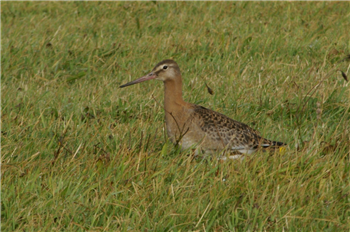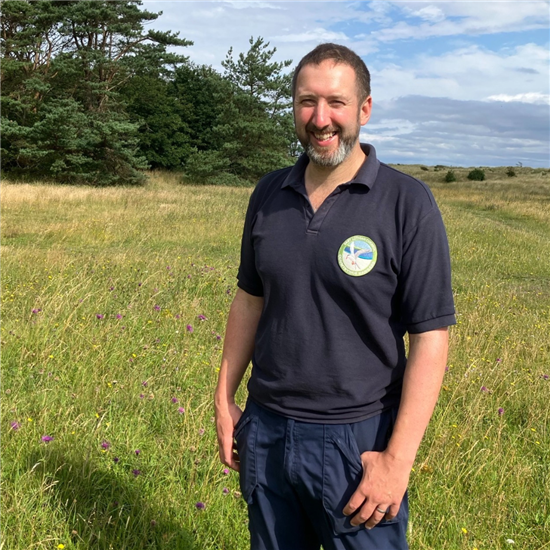A Ranger Writes: wading birds
Our Countryside Rangers have a wealth of knowledge on the places, plants and species that call East Lothian Home. Ranger Richard English offers some insights into wading birds and explains why these elegant birds are worth looking out for.
We’re fortunate in East Lothian to have coastal areas and river estuaries that provide great habitats for wildlife. These habitats are exploited by all manner of species – plants, animals and fungi. Better minds than mine will also be able to point to the many millions of single-celled organisms that thrive in these areas, but that’s a bit beyond the scope of this humble column.
'Summer finery'
 A Barwit. Image by Ian Andrew
A Barwit. Image by Ian Andrew
Wading birds, or waders, are a common sight along the coast, particularly near the mouths of the Esk, Peffer Burn and Tyne. As the name suggests, these birds spend much of their time in shallow water, or on mudflats, seeking out the rich and varied food resources found there. At this time of year, it’s worth looking out for waders that are still in their summer plumage, having recently returned from their breeding grounds. Winter plumage waders are generally a rather drab bunch, but in their summer finery they can be spectacular.
Godwits are a group of waders which consist of only four species worldwide. Two of these, the marbled and Hudsonian godwits are found in the Americas, but the other two are regular visitors to East Lothian. Both of these species, the bar-tailed and black-tailed godwits, are long-legged, long-billed birds. They can be tricky to tell apart, but at least they’re fairly easy to distinguish from other waders.
 Blackwit photographed by Mike Pennington
Blackwit photographed by Mike Pennington
The bar-tailed godwit is the more common of the two – it’s not unusual to see flocks of several hundred at a time. They breed in Scandinavia and northern Russia, but will pass through the UK during spring and autumn migration, and many will over-winter on our coast. By contrast, black-tailed godwits have a (very) small breeding population in England, but in this part of the country they’re only really seen as migrants passing through on their way south from Iceland.
Dramatic plumage
One of the main distinguishing features between the species is, not surprisingly, the pattern of the tail. In the bar-tailed godwit, the tail feathers form a series of dark and light bars (yes, it’s that simple), topped by a long white wedge that runs up the bird’s back. The black-tailed version has a single broad black band on the tail, with a noticeable white square above it. The latter also has white wing bars which are very obvious in flight. In summer, both species have dramatic orange-red plumage about their throat and chest, but this fades as autumn approaches. In winter both species appear grey-brown, although the bar-tailed godwit shows more streaking on its head, neck and back. The black-tailed tends to be a much more uniform grey.
The genus name for godwits is Limosa, derived from the Latin limus, meaning mud, reflecting the birds’ preferred feeding habitat. Godwit itself may be imitative of the bird’s call, although an alternative derivation is from the Anglo-Saxon god and whita, indicating an animal that is good to eat. Whatever the source of the name, both of these godwit species are attractive and elegant parts of our local wildlife and well worth searching out.
More on our Countryside Rangers
Meet Robbie! Find out more about a Ranger's role in summer season and what an average day looks like (spoiler: there's no such thing).
Meet Countryside Ranger Robbie

Countryside Ranger Robbie MacEwen is busy all year round, but summer presents a unique set of challenges.
The 39-year-old is based at Yellowcraig and Archerfield where residents and visitors flock to the county’s beautiful coastline during the warmer weather.
Describing the sites under his care as “magical”, Robbie is dedicated to both their preservation and encouraging people of all ages to enjoy them safely.
He said: “I genuinely love my job. I really look forward to going to work and I often wake up with a spring in my step about the day ahead.
“I feel I’m making a difference and I’m passionate about protecting the environment and enhancing biodiversity while helping everyone to experience the outdoors in a responsible and sustainable way.”
"Established and knowledgeable team"
Robbie joined our Countryside Rangers Service just over three years ago. Before that he’d spent eight years as a Park Ranger with Historic Environment Scotland.
He said: “The East Lothian Council Rangers have a great reputation as a very established and knowledgeable team who were the first council-funded Rangers service in Scotland. It was a wonderful opportunity to join them and I’ve learned so much. No two days are the same in my job which is something I relish.”
Robbie, who lives in Musselburgh, divides his work into three broad categories - interpretation, monitoring and maintenance.
“Interpretation can take the form of talks and outdoor learning for groups ranging from nursery classes to retirees," explained Robbie. "We do a lot of educational work on topics like ecology, geography, sustainability, and biodiversity. Then there’s the informal education with people we meet on patrol where we stress the message of ‘leave no trace’ - the idea that you should leave nothing but your footprints to help preserve our countryside.
“Monitoring involves counting plants and animals to keep our finger on the pulse of what’s happening. We monitor our Sites of Special Scientific Interest to check on biodiversity levels and factors which might threaten the ecology of an area.
“With maintenance we deal with health and safety issues, check woodlands for wind-blown trees or storm damage, maintain paths, and record signs of erosion. We carry out litter picking and clean up fire sites as well as getting involved in more specialised habitat management. That might be looking after grasslands and coastal dunescapes, some of which need extra TLC to keep the plants, animals, and fungi happy.”
Promoting safety
During the busy summer months, Robbie spends a great deal of time promoting safety and helping to reduce risks for those visiting Yellowcraig and Archerfield.
He said: “Irresponsible camping can presents various issues, including threats posed by fires. In the nicer weather we ask the question of whether visitors need to have a fire at all. If someone is determined to have a fire, they should have it on the beach, which is tough and resilient, and keep it attended at all times. Once finished, put the fire out with water, don’t just cover it with sand which traps in the heat and conceals a hazard for others. We have special metal bins at our big sites like Yellowcraig and Gullane where disposable barbecues can be safely discarded.
“With regards to water safety, if you’re in trouble or see someone in trouble, don’t hesitate to call 999 for the Coastguard. We try to raise awareness on riptides and where they can be found. People should also be aware of offshore winds which can take you away from the coast. Check the weather forecast and have a ‘buddy’ if you’re involved in activities on the water – someone who knows where you are going and when you’ll be back so they can raise an alarm. More information is available on the Water Safety Scotland website and they really know their stuff.”
Thanks to Robbie and all our Countryside Rangers for the brilliant work you do.